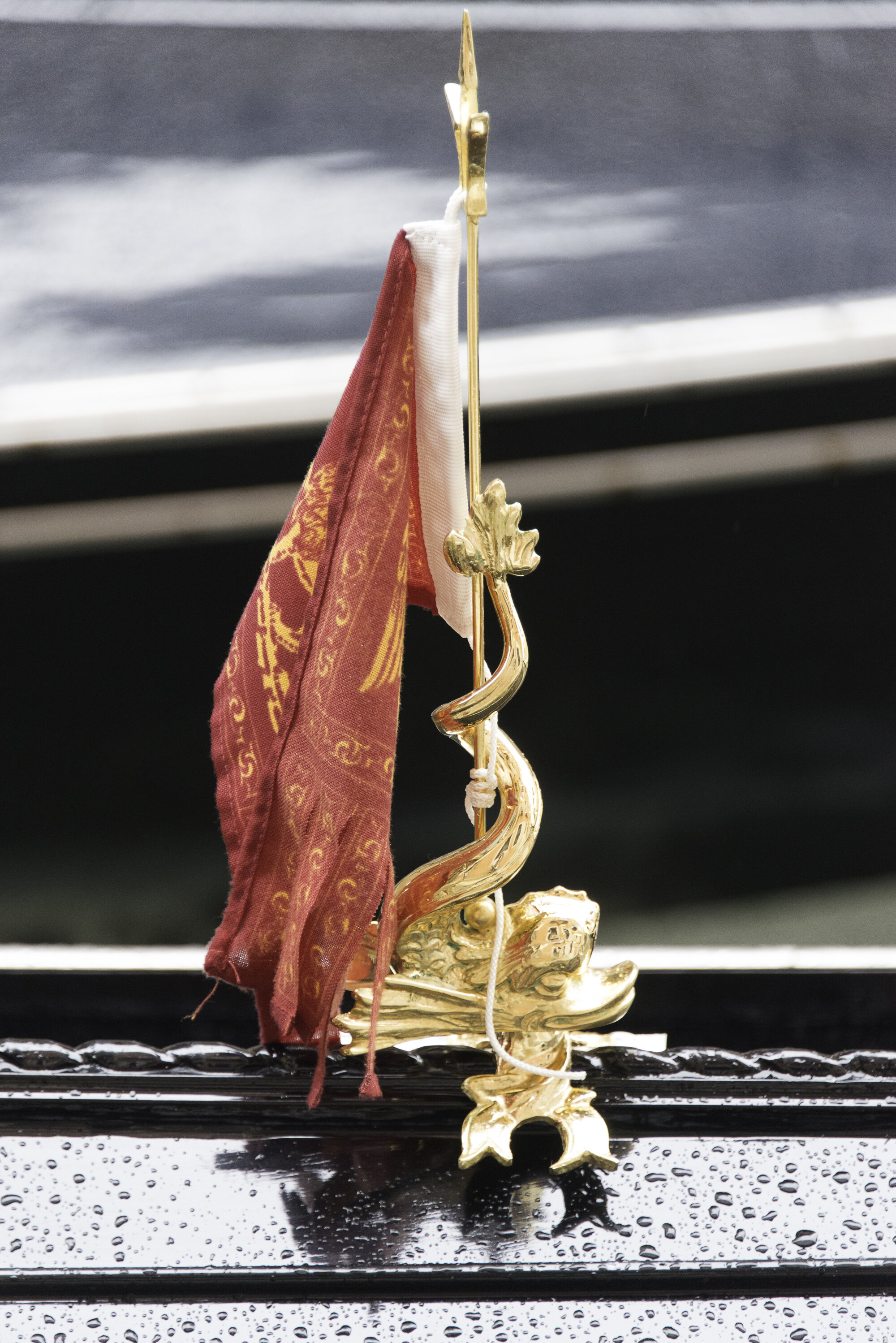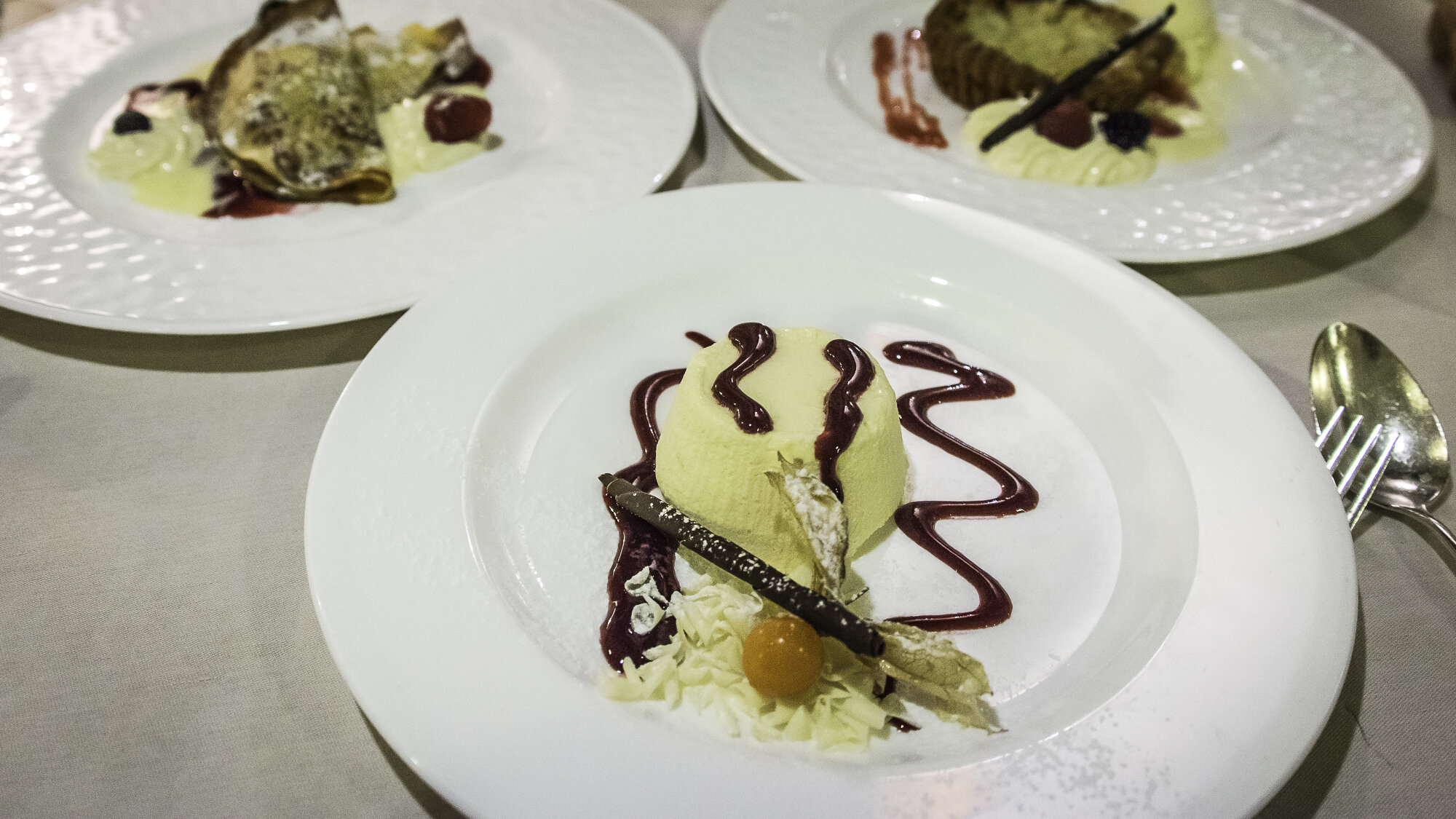Quando sono solo, sogno Venezia. And when I’m having those dreams of Venice, I will assuredly picture ‘the gondola’. The gondola is the iconic symbol of Venice…and its been that way for over 900 years.
What does a gondola look like? Let’s try this. Close your eyes and image a canoe. Go ahead, I’ll wait.
Ok, now…uh oh…your eyes are closed and you can’t read what I’m now writing to you. I’ll just have to wait until you’ve exhausted your dreamlike state.
Wait…
Wait…
[And while I’m waiting, I’m going to remember one of my all time favorite gondola photos that I took in Venice…but actually it is a composite of several photos, and you can see how I did it here.]
“Procession”
Wait…
Wait…
Welcome back, and sorry about that…I should have thought ahead about you having your eyes closed.
Now, completely erase from your mind that canoe image, because the only similarity to a gondola is that they both float (well, Ellen and I had a canoe issue where it didn’t float, but that’s a different story).
Here are some significant differences between a canoe and a gondola:
Squerarioli hand crafting a gondola in their squero (workshop)
A canoe is symmetrically straight, while a gondola is asymmetrically shaped like a banana.
A canoe is around 15-16 feet long and perhaps 35 inches wide, while a gondola is 35-feet-7-inches long and 55 inches wide.
Where a canoe is typically around 75 pounds, a gondola tips in at 1,545 pounds…yikes!
While you and your canoeing partner sit within the canoe and use paddles, the gondolier stands not within, but atop, and at the rear of the gondola, and uses a single oar.
Where standing up in a canoe is a recipe for tipping disaster, standing up in a gondola is not, and is the de facto way to ride in a gondola used as a traghetto, or ferry, to get across the Grand Canal where no bridge is close by.
And, where sitting side-by-side in a canoe (and even getting into that position without tumping over) doesn’t allow one to relax during that endeavor, there is nothing more relaxing than sitting by your loved one in a gondola as you enjoy your romantic gondola ride.
So, let’s learn more about the gondole (plural of ‘gondola’) of Venice.
History
As I mentioned above, the gondola has been associated with Venice for around 900 years.
Illustration of early-day gondola by Jost Amman
Today’s gondola is of shiny black lacquer and each is mostly identical, except for the custom-designed lounging area and some of the gondolier’s personally-applied decoration.
In days gone by, some gondole had canopies covering them, where romantic rendezvouses and political intrigue took place.
As there were no motorized vaporetti nor water taxis to carry one about, there were around 10,000 gondole bumping into each other along the Grand (and lesser) Canal.
Some were so ostentatious and of such a troublesome size that the Venetian government put its foot down and decreed that all should be black and of similar size.
Besides their size and color, there is another historical element on the prow of each gondola. This element is the ferro (or ‘iron’). The design of the ferro takes into account many aspects of the Venetian lagoon. I’ll explain the significance of the ferro shortly.
Now, to construction of the gondola.
Construction
Here is a short quiz for you - how many of the following woods are used in the construction of a gondola?
oak
fir
cherry
larch
walnut
linden
mahogany
elm
Of the 8 woods listed above…wait for it…all 8 are used in the construction of a gondola.
Here are some other facts to consider as, in the future, you close your eyes to picture a gondola, instead of a canoe.
Recently deceased master squerariolo Roberto Tramontin ready to launch a newly completed gondola
How many pieces of wood make up a gondola? 280…each cut to specific, traditional dimensions and assembled in a precise order.
How does the gondola get its banana shape? One side is 10 inches longer than the other.
Why the banana shape? To counteract the weight of the gondolier and the torque created by the gondolier using the single oar on the starboard side of the boat.
How many gondoliers are there? About 450.
Giorgia Boacolo - first woman gondolier
Are all gondoliers men? If you had asked just a few years ago, the answer would have been ‘yes’, and that’s the way it was for 900 years. Generally, the father passed the license down to the son. But recently, 23-year-old Giorgia Boacolo made it through the 400 hour training coarse to become the first woman gondolier. You go, girl!
How many gondola ‘sheds’ or ‘squeri’ or workshops are there? There are two, though the recent death of Roberto Tramontin has placed the Squero Tramontin e Figli in jeopardy.
How many days does it take to make a single gondola? It takes 45 days with 5 squerarioli (carpenters) working full time.
How much does a gondola cost? On average, a gondola costs $61,000.
The Forcula
Without the forcula, there is no gondola…it’s as simple as that.
The forcula and its named parts
Many say that the forcula looks a bit like a hand, as you can see in this photo of a forcula. Maybe it looks a bit like a hand…maybe not a big bit like a hand, but maybe an itty bitty bit like a hand. Actually, I don’t see a hand at all, just kind of a wooden twisty thing.
It is sculpted from a single piece of walnut that has been aged up to 3 years. And when I say sculpted, that’s exactly how it is produced. Each forcula is designed specifically for an individual gondolier, based on their height and rowing style.
The forcula’s gamba (leg) is inserted into a hole in the gondola's deck.
And being a work of sculpted art, the forcula is detached from the gondola each evening…it is a very personal thing.
After retirement, a gondolier’s forcula can be found on their home’s mantel, as a testament to their career.
In this photo showing Debbie and Scott during a pre-dinner romantic gondola ride, you can see how the gondolier applies his oar to the forcula.
There is no connection between the oar and the forcula, as the gondolier must be able to place the oar on various parts of the forcula to achieve forward, backward, side-to-side and turning locomotion.
It’s really amazing to watch these masters shuck and jive through tiny canals, often putting a foot up on a wall to push off to help steer through difficult situations.
The Ferro
Representative parts of the gondola’s ferro
The ferro, or ‘iron’ is located on the prow of the gondola. For those of you who are not familiar with the term, the prow is the front of a boat.
Note the six forward facing prongs. These represent the six sestieri, or districts, of Venice. The rear-facing prong represents the island of Giudecca.
There is often, but not always, 3 little shrimp looking thingies interspersed between the prongs. These represent the main islands associated with Venice, which are Murano, Burano and Torcello.
The top is representative of a Doge’s cap. This is the cap of office that the Doge, or president-like-guy of the Venetian empire, would wear.
The photo also shows some of the other Venetian iconic symbols that have been woven into the ferro’s design.
Decorative Elements
Here you can see a number of embellishments that the gondoliers are allowed to personalize. Many of the accoutrement feature a golden seahorse-styled sculpture.
A Squero - Or Gondola Workshop
These photos are of the Squero di San Trovaso, which we glimpsed during our quiet Venetian walk just recently.
The Gondolier’s Platform
Notice in these two photos how the gondoliers stands near the rear of the gondola, and they are somewhat cantilevered above the water.
Singing Gondoliers
Do you want a singing gondolier? They don’t do that. But, you can arrange ahead of time for a singer to join you on your gondola ride…usually accompanied by an accordionist. Plan to pay a good bit more.
But hey, avoid the cost and do your own singing. Here you can see Ellen, Craig and Leslie singing their hearts out as we glide along the Grand Canal. As we couldn’t think of the words to any particular song that we all knew (one time we had to resort to ‘White Christmas’!), the iPhone comes in handy.
Parting Shots
I’ll leave you with some photos from some of our favorite gondola rides.
That’s it for today folks. I hope that you’ve enjoyed seeing how gondole are made and used…and how they are so much different from canoes.
And, as you take your own romantic gondola ride, look back at your gondolier…it just may be me oaring away behind you, as together, we ply the canals of Venice.
For a small tip, I’ll sing for you…and then for a bit larger tip, I’ll stop singing! See how that works?




































